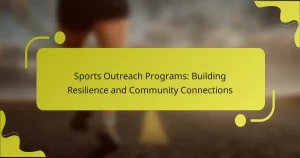Local sports initiatives play a crucial role in enhancing community cohesion and engaging youth. They foster relationships, promote teamwork, and provide structured activities that develop essential life skills. Successful programs rely on community involvement, accessibility, and sustainable funding. Measuring impact through participation rates and community feedback helps ensure these initiatives meet the needs of diverse populations.

How do local sports initiatives enhance community cohesion?
Local sports initiatives enhance community cohesion by fostering relationships, promoting teamwork, and engaging youth. These programs create shared experiences that unite diverse groups, leading to stronger social ties. Participation in local sports helps develop essential life skills, such as communication and collaboration. As a result, communities experience increased trust and a sense of belonging, contributing to overall social well-being.
What social benefits arise from community sports programs?
Community sports programs foster social benefits like enhanced community cohesion and increased youth engagement. They create opportunities for diverse groups to connect, promoting inclusivity and teamwork. Participation in sports encourages positive relationships among residents, reducing social isolation. Programs also provide youth with constructive activities, steering them away from negative influences. Studies show that communities with active sports initiatives report higher levels of trust and collaboration among members.
Which community demographics are most impacted by sports initiatives?
Local sports initiatives significantly impact youth and marginalized communities. These programs enhance engagement, promote teamwork, and foster social cohesion.
Demographics most affected include low-income families, racial minorities, and youth aged 6-18. For instance, communities with limited access to recreational facilities benefit from organized sports.
As a result, participation in sports initiatives often leads to improved physical health, increased academic performance, and enhanced life skills among participants.
How do local sports initiatives foster inclusivity among diverse groups?
Local sports initiatives promote inclusivity by bringing together diverse groups through shared activities and teamwork. These programs create safe environments where individuals from various backgrounds can interact, fostering mutual respect and understanding. Participation in local sports enhances community cohesion by encouraging collaboration and breaking down social barriers. Studies show that youth engaged in inclusive sports initiatives develop better social skills and a sense of belonging, positively impacting their overall well-being.

What role do local sports initiatives play in youth engagement?
Local sports initiatives significantly enhance youth engagement by fostering community cohesion. They provide structured activities that promote teamwork and social skills while reducing isolation. Participating in local sports can improve physical health, instill discipline, and cultivate leadership qualities among youth. These initiatives often include mentorship programs, which connect young athletes with role models, further strengthening community ties. As a result, local sports initiatives serve as vital platforms for youth development and community integration.
How do sports programs influence youth development and life skills?
Local sports programs significantly enhance youth development and life skills by promoting teamwork, discipline, and resilience. These initiatives foster a sense of belonging and community engagement, which are essential for personal growth.
Participation in sports teaches youth valuable life skills such as communication and leadership. For instance, working towards a common goal in a team setting encourages collaboration and conflict resolution.
Moreover, local sports initiatives often provide mentorship opportunities, connecting youth with positive role models. This relationship can lead to improved self-esteem and motivation to pursue academic and personal goals.
Lastly, involvement in sports can reduce negative behaviors by offering structured activities and a supportive environment. As a result, youth are more likely to develop a strong sense of responsibility and civic engagement.
What types of sports initiatives are most effective for engaging youth?
Local sports initiatives that focus on community involvement and skill development are most effective for engaging youth. Programs that incorporate mentorship, teamwork, and local partnerships foster a sense of belonging. Initiatives like after-school sports leagues, community tournaments, and youth training camps create regular participation opportunities. These activities not only improve physical health but also enhance social skills and community ties, making them valuable for youth engagement.
How do local sports initiatives address youth mental health and well-being?
Local sports initiatives significantly enhance youth mental health and well-being by fostering social connections and providing physical activity. These programs create supportive environments where young people can engage with peers, develop teamwork skills, and build self-esteem. Research indicates that participation in sports can reduce symptoms of anxiety and depression among youth, promoting overall mental wellness. Additionally, local initiatives often prioritize inclusive practices, ensuring that diverse youth populations benefit from these positive experiences.

Which unique attributes distinguish successful local sports initiatives?
Successful local sports initiatives are distinguished by community involvement, accessibility, and sustainable funding. These attributes foster engagement and ensure long-term impact.
Community involvement encourages local ownership, leading to higher participation rates. Accessible programs remove barriers, allowing diverse populations to engage in sports. Sustainable funding ensures initiatives can operate consistently, providing ongoing benefits.
Moreover, unique attributes like partnerships with schools and local businesses enhance visibility and resources. Initiatives that focus on youth development through mentorship programs create lasting impacts on community cohesion.
As a result, successful local sports initiatives contribute significantly to social bonds and youth engagement, transforming communities positively.
What innovative programs have emerged in different regions?
Innovative local sports initiatives have emerged globally, enhancing community cohesion and youth engagement. Programs like “Play Streets” in the UK encourage active play by closing streets to traffic, fostering neighborhood connections. In the U.S., “Youth Sports Alliance” promotes inclusivity by providing access to sports for underprivileged youth, strengthening community ties. In Australia, “Sports for Schools” integrates physical activity into education, improving student engagement and well-being. These initiatives demonstrate the power of sports in building vibrant, connected communities.
How do partnerships with local organizations enhance sports initiatives?
Partnerships with local organizations significantly enhance sports initiatives by fostering community engagement and providing resources. These collaborations create opportunities for youth involvement and promote social cohesion. Local organizations often bring expertise, volunteers, and funding, which amplify the reach and impact of sports programs. As a result, communities experience increased participation, improved facilities, and a stronger sense of belonging.

What challenges do local sports initiatives face in different communities?
Local sports initiatives face challenges such as funding shortages, community engagement, and resource accessibility. Limited financial support restricts program development. Low participation rates hinder youth engagement. Additionally, inadequate facilities can prevent effective training and competition. Addressing these issues is vital for enhancing community cohesion through sports.
How does funding impact the sustainability of sports programs?
Funding significantly enhances the sustainability of sports programs by providing necessary resources. Adequate funding ensures consistent access to facilities, equipment, and coaching. It also enables community outreach, fostering youth engagement and participation. Moreover, financial support can lead to improved program quality, attracting more participants and volunteers. As a result, stronger community cohesion develops through shared experiences and teamwork.
What barriers prevent participation in local sports initiatives?
Barriers to participation in local sports initiatives include lack of access, financial constraints, and limited awareness. Many communities face inadequate facilities or transportation options, which hinders youth engagement. Additionally, high registration fees can deter families from enrolling their children. Finally, insufficient promotion of local sports programs reduces community involvement, resulting in lower participation rates.

How can local sports initiatives measure their impact on the community?
Local sports initiatives can measure their impact on community cohesion and youth engagement through surveys, participation rates, and community feedback. These metrics provide insights into social connections and youth involvement.
Surveys assess community sentiment and gauge changes in relationships fostered by sports programs. Participation rates highlight engagement levels, showing how many youth are involved over time. Community feedback offers qualitative data, revealing personal stories and experiences linked to local sports initiatives.
Additionally, tracking volunteer involvement and partnerships with local organizations can demonstrate broader community support and collaboration, reflecting the initiative’s overall impact.
What metrics are used to evaluate the success of these initiatives?
Local sports initiatives are evaluated through metrics like participation rates, community feedback, and social cohesion indicators. These metrics assess youth engagement and the overall impact on community well-being. Participation rates reflect the number of individuals involved, while community feedback gathers qualitative insights. Social cohesion indicators measure relationships and trust among community members, highlighting the initiatives’ effectiveness in fostering unity.
How can feedback from participants improve local sports programs?
Feedback from participants significantly enhances local sports programs by identifying strengths and areas for improvement. Engaging with community members fosters a sense of ownership and encourages active participation.
For example, surveys and focus groups can reveal preferences regarding activities, scheduling, and facilities. This direct input allows program coordinators to tailor offerings, increasing youth engagement and retention.
Moreover, participant feedback can highlight unique attributes of programs, such as inclusivity or accessibility, which are vital for attracting a diverse audience. As a result, programs that adapt based on feedback are more likely to strengthen community cohesion and meet the needs of local families.

What best practices can enhance the effectiveness of local sports initiatives?
Local sports initiatives can enhance effectiveness through community involvement, structured programs, and partnerships. Engaging local organizations fosters collaboration and resource sharing. Structured programs tailored to youth interests increase participation and retention. Partnerships with schools and businesses provide funding and facilities, creating a supportive environment. Regular feedback from participants ensures initiatives meet community needs, promoting sustainability and growth.
How can communities foster greater volunteer involvement in sports programs?
Communities can foster greater volunteer involvement in sports programs by creating inclusive environments and promoting local initiatives. Engaging local organizations enhances outreach and builds connections.
1. Establish partnerships with schools and community centers to identify potential volunteers.
2. Host community events to raise awareness about sports programs and volunteer opportunities.
3. Provide training and support for volunteers to boost confidence and skills.
4. Recognize and celebrate volunteer contributions to encourage ongoing participation.
These strategies enhance community cohesion and promote youth engagement in sports.
What strategies can be employed to increase youth participation in local sports?
To increase youth participation in local sports, communities can implement targeted outreach, inclusive programs, and partnerships with schools. Engaging local influencers can also motivate youth involvement.
Outreach initiatives can include social media campaigns, community events, and school presentations to raise awareness. Inclusive programs should cater to diverse interests and skill levels, ensuring every youth feels welcome. Collaborating with schools can facilitate access to facilities and resources, enhancing participation.
Involving local athletes or coaches as role models can inspire youth. Programs that incorporate fun elements, such as competitions or festivals, can attract more participants. Regular feedback from youth can help tailor initiatives to their preferences, ensuring sustained engagement.
Which common mistakes should be avoided in implementing sports initiatives?
To successfully implement sports initiatives, avoid common mistakes such as insufficient community engagement, lack of clear objectives, inadequate resource allocation, and failure to evaluate outcomes. These errors can hinder the effectiveness of local sports initiatives aimed at enhancing community cohesion and youth engagement. Engaging stakeholders early ensures initiatives meet community needs, while setting measurable goals helps track progress. Proper funding and resources are essential for sustainability, and regular assessment allows for necessary adjustments.




